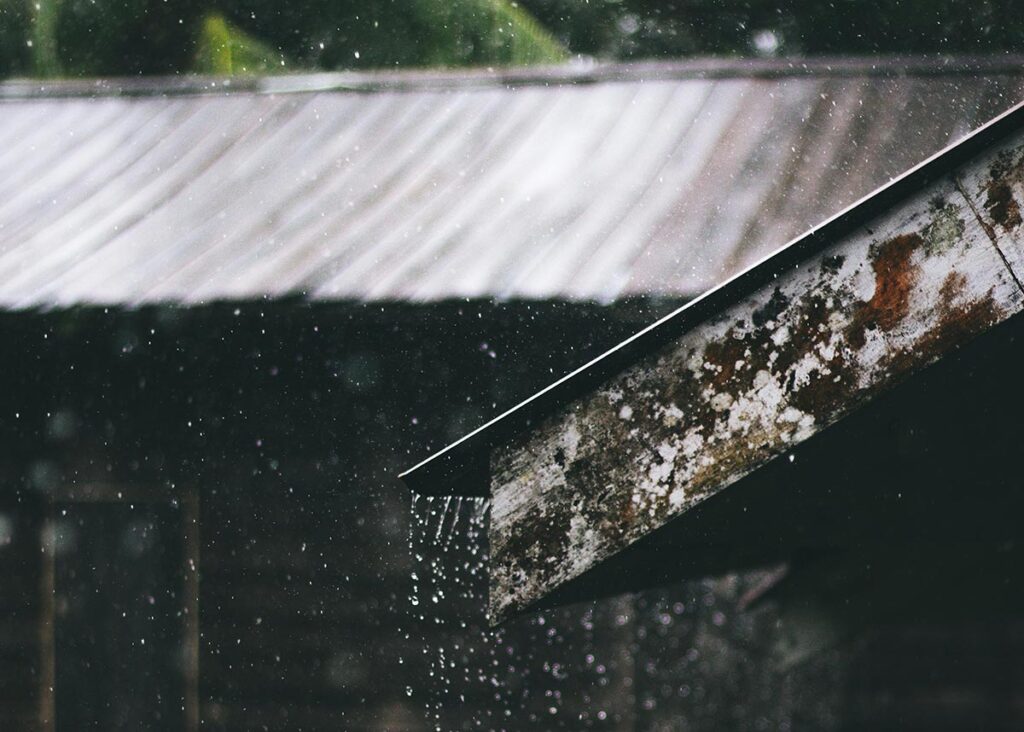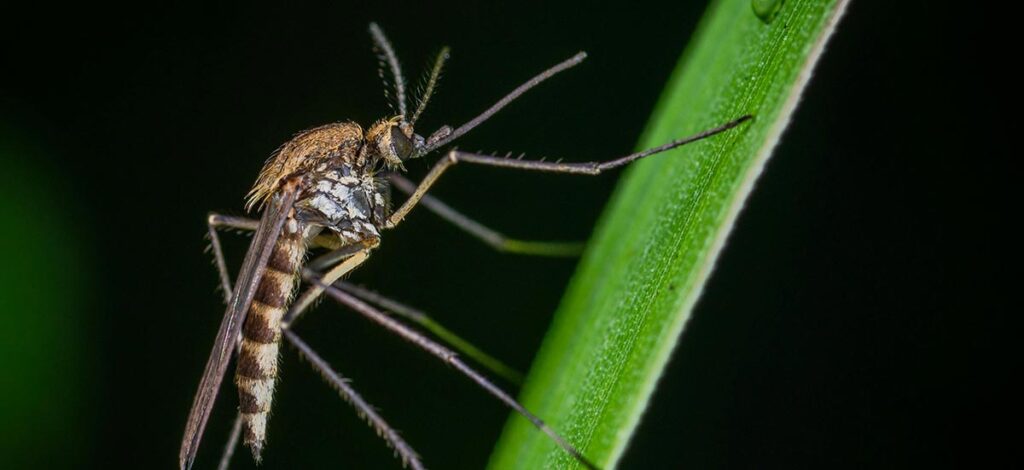by P.E. Cabot, C.C. Olson, R.M. Waskom and K.G. Rein* (4/16)

Quick Facts
- Most homeowners in Colorado are allowed to use rain barrels to collect rainwater.
- A maximum of two rain barrels with a combined storage of 110 gallons or less are allowed at each household.
- Collected rainwater may be used to irrigate outdoor lawns, plants or gardens.
- Untreated rainwater collected from roofs is not safe to drink
The purpose of this factsheet is to provide information about the regulatory and health aspects of rainwater collection in Colorado. The information provided in this factsheet is based primarily on language in Colorado House Bill 16-1005 and is intended to inform citizens on how to properly use rain barrels in accordance with Colorado law.
What is rainwater collection?
Rainwater collection, also called rainwater “harvesting,” is the process of capturing, storing and directing rainwater runoff and putting it to use. Water from roof gutter downspouts is usually directed onto landscaped areas and is incidentally consumed by plants, but this form of use is not regarded as rainwater harvesting.
Actual rainwater harvesting involves the collection of rainfall runoff from rooftops, concrete patios, driveways and other impervious surfaces. Rainwater collection systems vary from the simple and inexpensive to the complex and costly. Typically, rooftop rainwater collection systems are simple, consisting of gutters, downspouts, and storage containers. Inexpensive rainwater storage systems commonly make use of an above ground container such as a barrel or plastic tank with a lid to reduce evaporation and bar access for mosquitos to breed. Any container capable of collecting the rain shedding from a roof or patio can be used as a rainwater harvesting system, but to be in conformance with Colorado water law, the container additionally must be equipped with a sealable lid. More sophisticated systems have “first flush” diverters that are recommended to exclude capture of the initial rain that might carry impurities from the roof.
Water rights issues concerning rainwater collection
Colorado residents should understand that water rights in Colorado are unique compared to other parts of the country. The use of water in this state and other western states is governed by what is known as the prior appropriation doctrine. This doctrine of water allocation controls who uses water, how much water may be used, the types of uses allowed, and when those waters can be used. A simplified way to explain this system is often referred to as the priority system or “first in time, first in right.” It may seem strange that rainwater harvesting in Colorado is so carefully watched, but understanding why this is so can provide valuable insight into the way water is shared in Colorado. In our arid environment, every drop counts and water rights holders depend upon the runoff from snowmelt and rainfall to supply the beneficial uses to which they apply their water rights. Captured precipitation that is consumed “out of priority” may deprive downstream and/or senior water right holders of their right to use water from the natural stream, which comprises water that originates as snow and rain. Even though the detention of rooftop precipitation might only be temporary and minimal, it may still alter the nature of historic flow patterns.

How to use rain barrels legally in Colorado
In order to safeguard senior holders of Colorado water rights, diverting and storing water is allowed only during times when all water rights in the basin are satisfied. It is impractical, however, for homeowners to know at all times whether water rights are satisfied. To collect rainwater without regard for other water rights, there are two laws which establish allowances for the limited collection of rainwater from rooftops of residential dwellings. These laws are further described below. Prior to the passage of House Bill 16-1005, in particular, rainwater collection was not permitted except under specific circumstances.
There are several restrictions that are important to follow in order to use rain barrels legally in Colorado. These restrictions differ depending on your residential situation.
Rain barrel use under HB16-1005
Under House Bill 16-1005, rain barrels can only be installed at single-family households and multi-family households with four (4) or fewer units. A maximum of two (2) rain barrels can be used at each household and the combined storage of the 2 rain barrels cannot exceed 110 gallons. Rain barrels can only be used to capture rainwater from rooftop downspouts and the captured rainwater must be used on the same property from which the rainwater was captured, for only outdoor purposes, including to water outdoor lawns, plants and/or gardens. Rain barrel water cannot be used for drinking or other indoor water uses.
It is important for rain barrel users to understand that the capture and use of rainwater using rain barrels does not constitute a water right. HB16-1005 includes language that could result in the State Engineer curtailing the use of individual rain barrels if a water right holder can prove that those rain barrels have impacted their ability to receive the water that they are entitled to by virtue of their water right.
Rain barrel use under SB09-080
Under special circumstances explained in Senate Bill 09-080, rural residents that qualify for “exempt” wells may collect rainwater with a Rooftop Precipitation Collection System Permit from the Colorado Division of Water Resources. Though these collection system permits do not limit the size of the rain barrel, the water must be collected from the roof of the primary residence and the rainwater may only be used for the uses allowed under the resident’s exempt well permit. For example, if the well permit allows for household uses only, then the rainwater could only be applied to non-potable uses in the residence; if the well permit allows for household uses and outdoor uses including lawn and garden irrigation and/or animal watering, then the rainwater could also be used for those uses.
Colorado residents that qualify for exempt well permits may be able to collect 110 gallons of water under HB16-1005 and collect rainwater for additional uses under SB09-080, so long as they can meet the restrictions described for the two laws.
Rooftop Precipitation Collection System Permit applications can be obtained from the Colorado Division of Water Resources. The application provides notice of intent to collect precipitation and a description of how it will be captured. Instructions on acquiring a rooftop precipitation collection permit can be found at the website for the Colorado Division of Water Resources, under the category “Well Permitting” and sub-category “Rainwater Collection (requiring Exempt Well).” To qualify for a Rooftop Precipitation Collection System Permit, you must satisfy these conditions:
- The property on which you collect the rainwater is residential property.
- You have a permit to use an exempt well, or you are legally entitled to an exempt well for the water supply.
- You collect rainwater only from the rooftop of your domestic residence.
- You use the water only for those uses that are allowed by, and identified on your well permit.
Rainwater collection under HB09-1129
Another special circumstance outlined in Colorado HB09-1129 allows developers to participate in pilot projects that harvest rainwater and put it to beneficial, though non-essential, use in the subdivision. These projects may only operate according to an engineered plan, submitted to the state engineer for approval and eventually, to the water court. Individual landowners are not eligible for these pilot projects.

Concerns about mosquitos
In order to prevent rain barrels from becoming mosquito breeding grounds, it is important to follow several best practices. First, although any container can be used to collect rainwater, House Bill 16-1005 requires the container to be equipped with a sealable lid. Fortunately, many rain barrels that can be purchased online or from a local home supply store have lids. Second, the rain barrel should be completely emptied every month (or less). If you plan to be away from the home for more than a week, you should disconnect your rain barrel from the downspout.
Concerns about water quality
Rain in urban and industrialized areas may contain various impurities absorbed from the atmosphere, including arsenic and mercury. In Colorado, rain is infrequent, but rainwater quality is generally good. However, the infrequency of rainfall results in accumulation of bird droppings, dust and other impurities on rooftops between rain events. The presence of these impurities in collected rainwater is affected by roofing materials, pitch, and area and may occur in high concentrations when it does rain. Heavy metals such as cadmium, copper, lead, zinc, and chromium have been detected in rainwater collected from rooftops. The phenomenon of acid rain can also cause chemical compounds to be leached from roofing materials.
The best strategy is to filter and screen out contaminants before they enter the storage container. Dirty containers may also become a health hazard or a breeding ground for insects and other pests. Various methods can be used to purify rainwater. First-flush diverters ensure a certain degree of water quality in harvested rainwater. The first several gallons of runoff from a gutter, roof, or other surface are likely to contain various impurities such as bird droppings and dust. A first-flush device prevents this initial flow from draining into the storage tank. Many first-flush devices have a simple design. Such devices include tipping buckets that dump when water reaches a certain level. In addition, there are containers with a ball that floats with the rising water to close off an opening after an inflow of 5 gallons. Water is then diverted to a pipe leading to the storage container. This use of simple technology is an attractive feature of rainwater harvesting. Roof washing is not needed for water used solely for irrigation purposes.
Due to concerns surrounding microbial contamination of harvested rainwater, it is not recommended as a source of drinking water for humans. However, properly designed, constructed, and maintained systems that include disinfection steps have been successfully used for private domestic water supplies.
Homeowner’s association rain barrel restrictions
A homeowner’s association (HOA) cannot ban the use of rain barrels by its members, however it can impose “reasonable” aesthetic requirements about the location and/or appearance of rain barrels. For example, an HOA may require that rain barrels be placed in backyards and/or be a certain color that blends into the outdoor landscape.
| An appropriation is made when an individual physically takes water from a stream or well (when legally available) and puts that water to beneficial use. The first person to appropriate water and apply that water to use has the first right to that water within a particular stream system. This person, after receiving a court decree verifying their priority status, then becomes the senior water right holder and that water right must be satisfied before any other water rights are filled. In Colorado, the state engineer and director of the Colorado Division of Water Resources, has the statutory obligation to protect all vested water rights. The process of allocating water to various water users is traditionally referred to as water rights administration, and is the responsibility of the Division of Water Resources. |
Frequently Asked Questions (FAQs)
Q. Do I Need a Permit to Use Rain Barrels?
The passage of HB16-1005 allows the use of two rain barrels without the need for obtaining a special permit, as long as the collected precipitation is used for outdoor purposes, including irrigation of lawns and gardens. However, if you want to use rain barrels as described and allowed by SB09-080, you will need to obtain a rainwater collection permit from the Colorado Division of Water Resources.
Q. Can I send downspout water onto my garden?
Yes. This situation is acceptable as long as rainwater is directed from the rooftop to the garden.
Q. How much irrigation could I expect to accomplish with rain barrels?
Each time you collect the maximum 110 gallons of water allowed in rain barrels, you can adequately irrigate approximately 180 square feet (a bit smaller than a 15 foot by 15 foot area) of vegetable garden or lawn area with the captured water. This estimate is based on CSU Extension recommendations to water lawns and vegetables gardens with about 1 inch of water during each irrigation cycle. However, a typical rain barrel user can only expect the rain barrels to completely fill about 10-15 times during the growing season, while vegetable gardens and lawns need to be irrigated at least twice as times per year depending on watering practices. Thus, supplemental irrigation will still be necessary to maintain a healthy lawn and vegetable garden.
Q. Can I use rainwater to water my horse/sheep/chickens?
HB16-1005 permits rainwater collection specifically for landscape uses only. Therefore, rainwater collected in rain barrels as allowed by HB16-1005 cannot be used for animal watering. However, rainwater collected in rain barrels as allowed by a Rooftop Precipitation Collection System Permit issued under SB09-080 can be used for animal watering, but only if the exempt well permit allows animal watering. Refer to the Rain barrel use under SB09-080 section above for more detail.
Q. Can I water an attached greenhouse? Can I water houseplants? What’s the line between many houseplants and a greenhouse? Is a sunroom with plants legal?
HB16-1005 permits rainwater collection specifically for outdoor uses. The basic SB09-080 permit stipulating “ordinary household use in one single-family dwelling (no outside use)” would support a reasonable understanding of “ordinary household use in one single-family dwelling (no outside use)” that includes watering of typical household plants in a sunroom or otherwise, especially if the water is taken from indoors. The SB09-080 permit would NOT allow for watering plants in a greenhouse where such a building is specifically dedicated to growing plants. There is no definitional line between “many houseplants” and a greenhouse, unless obviously the greenhouse is an attached room or detached building used specifically dedicated to growing plants.
Q. Can I wash my car with collected rainwater?
HB1005 states that captured rainwater must be used on the same property from which the rainwater was captured, for outdoor purposes only. This could include uses such as washing your car on your property. Permits authorized under SB09-080 stipulate “ordinary household use” in one single-family dwelling (no outside use) and would NOT allow for car washing. Such use is limited to drinking and sanitary uses inside the home.
Q. Can I fill my outdoor hot tub with rainwater?
No. The permit authorized under SB09-080 stipulating “ordinary household use” would NOT allow the use of captured rainwater to fill an outdoor hot tub. This includes single-family or multiple dwelling unit situations.
Q. Can I flush my toilet with rainwater?
HB16-1005 permits rainwater collection specifically for nonpotable outdoor uses only. Therefore, rainwater collected in rain barrels as allowed HB16-1005 cannot be used for flushing toilets. However, flushing toilets would be considered “ordinary household use” and rainwater collected in rain barrels as allowed by a Rooftop Precipitation Collection System Permit issued under SB09-080 would be allowed.
Q. Can I put a dog – water dish outside? Can I wash my windows outside? Can I empty used water outside? Can I water a pot of flowers by my front door?
There are endless scenarios that are both humorous and pedantic. The basics of rainwater collection in Colorado are that it may be collected and used for lawns, gardens and landscapes. If you have a permit for rainwater collection under SB09-080, you may use the rainwater as a substitute for water that would ordinarily be pumped from your private exempt well and subject to the limitations of your well permit.
References and additional resources
- Lancaster, B. 2008. Rainwater Harvesting for Drylands and Beyond. Volume 2: Water‐harvesting Earthwork. Tucson, Ariz.: Rainsource Press. ISBN: 978‐0‐9772464‐1‐0.
- CDWR. 2008. Rainwater Collection in Colorado – Information Brochure. Available at: http://water.state.co.us/DWRIPub/Documents/DWR_RainwaterFlyer.pdf (last accessed February 2 , 2016).
- Jones K., Gross M., and Swift C.E. 2014. Watering Established Lawns – Colorado Extension Fact Sheet 7.199. http://extension.colostate.edu/docs/pubs/garden/07199.pdf
- King T.L. and Bedient P.B. 1982. Effect of acid rain upon cistern water quality. In: Proceedings of an International Conference on Rainwater Cistern Systems, University of Hawaii at Manoa, pp. 244-248.
- Lye, Dennis J. 2009. Rooftop runoff as a source of contamination: A review. Science of the Total Environment 407: 5429-5434.
- Whiting D., O’Meara C., and Wilson, C. 2015. Irrigating the Vegetable Garden – Colorado Master Gardener Fact Sheet #714. http://cmg.extension.colostate.edu/Gardennotes/714.pdf
- Yaziz M., Gunting H., Sapari N., and Ghazali A. 1989. Variations in rainwater quality from roof catchments. Water Research 23(6): 761-765
*P.E. Cabot, Research Scientist, Extension and Colorado Water Institute, Colorado State University, C.C. Olson, Research Associate, Dept. of Civil and Environmental Engineering, Colorado State University, R. M. Waskom, Director, Colorado Water Institute, Colorado State University, K.G. Rein, Deputy State Engineer, Colorado Division of Water Resources. 4/16.





